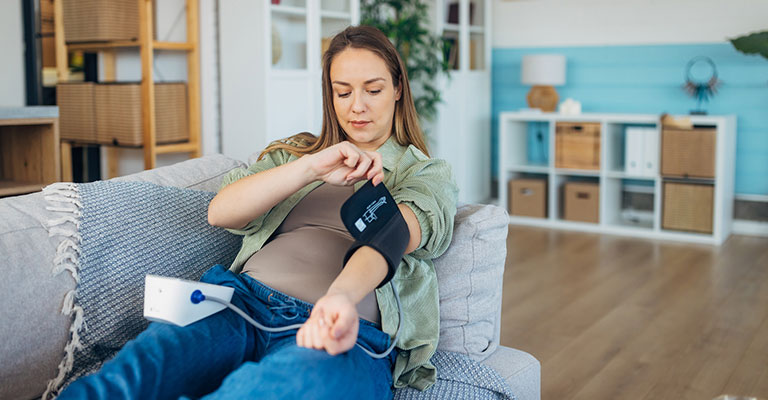Updated by the Progyny Clinical Team — June 2025
Gestational hypertension is high blood pressure that develops during pregnancy, typically after the 20th week. It’s a serious complication that occurs in 1 in 12 pregnancies. Preeclampsia is a more severe type of gestational hypertension, where a person has high blood pressure and signs of damage to other organs, most commonly the liver and kidneys.
If not diagnosed and treated, preeclampsia can cause serious complications for both the baby and birthing parent, including low birth weight or preterm delivery for the baby, and rare but serious complications such as seizures or strokes for the birthing parent. According to the Preeclampsia Foundation, the rate of preeclampsia in the US has increased by 25 percent in the last two decades and is a leading cause of maternal and infant illness and death.
Signs and symptoms
There are several signs and symptoms of preeclampsia that parents should be aware of, including:
High blood pressure (hypertension): Blood pressures above 140 mm hg systolic (top number of the blood pressure cuff) or above 90 mm hg diastolic (bottom number of the blood pressure cuff) are considered elevated. These are typically elevated on two separate occasions, at least four hours apart, to make the hypertension diagnosis.
Too much protein in the urine (proteinuria) shows that the kidneys are not working normally. During routine prenatal visits, a provider may test urine for protein.
Swelling (edema) can occur, particularly in the hands and face. While mild swelling is common during pregnancy, sudden or severe swelling should be reported to the provider.
Visual disturbances like blurry vision, flashes of light in the peripheral vision (scotoma), sensitivity to light (photophobia), and temporary loss of vision can be signs of preeclampsia.
Persistent headaches, which are different than usual headaches and not relieved by over-the-counter medications, can be a sign too.
New or increasing chest pain or shortness of breath should be reported to the provider. This goes beyond the mild shortness of breath that can be common at the end of pregnancy.
Upper abdominal pain, usually on the right side under the ribs, can be a symptom of liver involvement in severe preeclampsia. This pain may also come with heartburn, nausea, or vomiting.
Risk factors
There are certain risk factors that make it more likely to develop hypertension or preeclampsia during pregnancy:
- First pregnancies or those carrying a child with a new partner
- A history of hypertension or preeclampsia in a previous pregnancy, especially if it was severe or occurred early on
- Pre-existing high blood pressure (chronic hypertension)
- Other medical issues, such as diabetes, autoimmune disorders (such as lupus or Crohn’s disease), and kidney disease
- Birthing parents under age 20 or over age 40
- A family history of it, especially in a mother or sister
- Being overweight or obese prior to pregnancy
- Carrying twins, triplets, or more
- In vitro fertilization pregnancies
If the birthing parent has one of more of these risk factors, the provider may recommend starting daily low-dose aspirin. This may be started as early as 12 weeks to reduce risk.
Prevention and management
Going to all prenatal appointments allows healthcare providers to monitor blood pressure, urine protein levels, and other signs to recognize and treat preeclampsia.
A provider may recommend starting aspirin to reduce the risk of preeclampsia for those with one or more risk factors. Medications may be prescribed to lower blood pressure and prevent complications — it depends on how serious the condition is.
If the case is mild, it can usually be managed with regular checkups outside the hospital. But if it’s more serious, the person may need to stay in the hospital until delivery so doctors can closely watch and manage the symptoms.
The only cure is delivery of the baby and placenta. In some cases, if the condition is serious, providers may recommend delivering the baby early to avoid health problems for the birthing parent.
Those who have had preeclampsia should continue to monitor their blood pressure and symptoms postpartum. That’s because they remain at increased risk of complications such as eclampsia (seizures) and strokes.
Conclusion
Preeclampsia is a serious condition that requires prompt medical attention. Knowing the signs, symptoms, and risk factors is very important for early detection and effective management. This is to ensure the health and safety of both the birthing parent and their baby.
Regular prenatal care and communication with your provider is essential for the early identification and management of preeclampsia. If you have concerns about your risk of developing it, talk to your provider.
Progyny is here for you if you have any questions. Please contact your Progyny Care Advocate for support.
Disclaimer: The information provided by Progyny is for educational purposes only and is not medical advice. Always consult a qualified healthcare provider for medical guidance.
